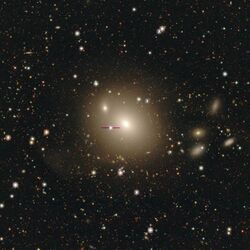Astronomy:NGC 7196
| NGC 7196 | |
|---|---|
 | |
| Observation data (J2000 epoch) | |
| Constellation | Indus |
| Right ascension | 22h 05m 54.8s [1] |
| Declination | −50° 07′ 10″ [1] |
| Redshift | 0.009750 ± 0.000063 [1] |
| Helio radial velocity | 2,923 ± 19 km/s[1] |
| Distance | 146 ± 48 Mly (45 ± 15 Mpc)[1] |
| Apparent magnitude (V) | 11.4 [2] |
| Characteristics | |
| Type | E:[1] |
| Apparent size (V) | 2.5′ × 1.8′ [1] |
| Other designations | |
| ESO 237- G 036, AM 2202-502, PGC 68020[1] | |
NGC 7196 is an elliptical galaxy registered in the New General Catalogue. It is located in the direction of the Indus constellation, at a distance of circa 150 million light years. It was discovered by the English astronomer John Herschel in 1834 using a 47.5 cm (18.7 inch) reflector.[2][3][4][5]
NGC 7196 appears slightly distorted, with asymmetric outer isophotes. Asymmetry is also observed near the centre. The inner luminosity pattern resembles that of lenticular galaxies with circumscribing dust lanes, except that the feature is extremely close to the center.[6] A shell has been observed around the galaxy. Shells are generally considered to have formed after the accretion of a smaller galaxy by a massive one.[7] It has weak radio wave emission.[8][9]
NGC 7196 is the foremost member of a galaxy group known as the NGC 7196 group, which also includes NGC 7200 and some dwarf elliptical and irregular galaxies. In the same galaxy cloud lies NGC 7168.[6][10] NGC 7196 lies in the foreground of galaxy cluster known as Abell S0989.[11]
See also
References
- ↑ Jump up to: 1.0 1.1 1.2 1.3 1.4 1.5 1.6 1.7 "NED Search Results for NGC 7196". http://ned.ipac.caltech.edu/cgi-bin/nph-objsearch?objname=NGC+7196.
- ↑ Jump up to: 2.0 2.1 "Revised NGC Data for NGC 7196". http://spider.seds.org/ngc/revngcic.cgi?NGC7196.
- ↑ "NGC 7196". http://simbad.u-strasbg.fr/simbad/sim-id?Ident=NGC+7196&jsessionid=DE48847DE94C4CCC0B477DF951F85DCC.
- ↑ "VizieR". http://vizier.u-strasbg.fr/viz-bin/VizieR-S?NGC+7196.
- ↑ Query Results from the ADS Database. "SAO/NASA Astrophysics Data System (ADS)". http://adsabs.harvard.edu/cgi-bin/basic_connect?qsearch=%22NGC+7196%22&version=1.
- ↑ Jump up to: 6.0 6.1 Sandage, A., Bedke, J. (1994), The Carnegie Atlas of Galaxies. Volume I, Carnegie Institution of Washington
- ↑ Tal, Tomer; van Dokkum, Pieter G.; Nelan, Jenica; Bezanson, Rachel (1 November 2009). "The Frequency of Tidal Features Associated with Nearby Luminous Elliptical Galaxies From a Statistically Complete Sample". The Astronomical Journal 138 (5): 1417–1427. doi:10.1088/0004-6256/138/5/1417. Bibcode: 2009AJ....138.1417T.
- ↑ Sadler, E. M. (January 1984). "Radio and optical observations of a complete sample of E and SO galaxies. III. A radio continuum survey at 2.7 and 5.0 GHz.". The Astronomical Journal 89: 53. doi:10.1086/113483. Bibcode: 1984AJ.....89...53S.
- ↑ Sadler, Elaine M.; Jenkins, C. R.; Kotanyi, C. G. (October 1989). "Low-luminosity radio sources in early-type galaxies". Monthly Notices of the Royal Astronomical Society 240 (3): 591–635. doi:10.1093/mnras/240.3.591. Bibcode: 1989MNRAS.240..591S.
- ↑ Makarov, Dmitry; Karachentsev, Igor (21 April 2011). "Galaxy groups and clouds in the local (z~ 0.01) Universe". Monthly Notices of the Royal Astronomical Society 412 (4): 2498–2520. doi:10.1111/j.1365-2966.2010.18071.x. Bibcode: 2011MNRAS.412.2498M. http://www.sao.ru/hq/dim/groups/galaxies.dat. Retrieved 19 January 2019.
- ↑ Coziol, R.; Andernach, H.; Caretta, C. A.; Alamo-Martínez, K. A.; Tago, E. (1 June 2009). "The dynamical state of brightest cluster galaxies and the formation of clusters". The Astronomical Journal 137 (6): 4795–4809. doi:10.1088/0004-6256/137/6/4795. Bibcode: 2009AJ....137.4795C.
External links
- NGC 7196 on WikiSky: DSS2, SDSS, GALEX, IRAS, Hydrogen α, X-Ray, Astrophoto, Sky Map, Articles and images
 |

